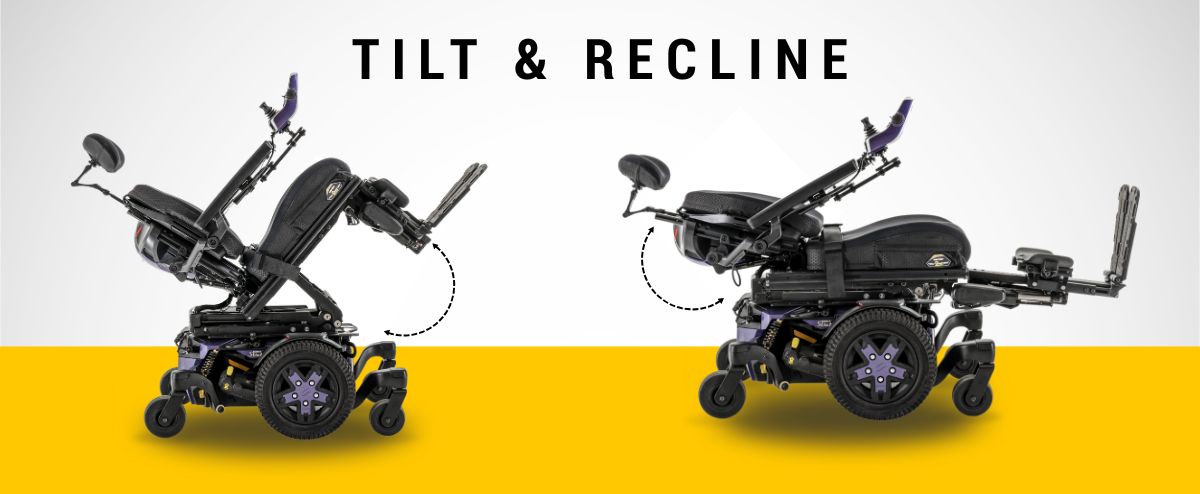Why Multiple Power Functions Matter in Powerchair Prescription
When it comes to prescribing a powerchair, especially for users with complex mobility needs, the inclusion of multiple powered seating functions can make a significant difference. While tilt or recline alone may offer some benefits, using these features in combination has been shown to deliver far more effective clinical outcomes.
When tilt and recline are used together, they form a clinically significant system that offers better pressure relief, improved positioning, and greater functional independence.
More Effective Pressure Management
A major reason clinicians recommend powered seating functions is pressure relief. Tilt helps redistribute body weight from the seat to the backrest, while recline shifts the body into a more open position. When combined, these functions allow users to achieve much greater pressure redistribution than either feature alone.
Used together, tilt and recline can reduce pressure on vulnerable areas and support skin integrity, especially for those at high risk of pressure injuries.
Supporting Joint Health Over Time
Recline is particularly helpful for allowing movement through a joint’s full range of motion. For users with limited mobility or neurological conditions, this movement is crucial to reduce the likelihood of contractures; permanent shortening of muscles and joints that can restrict function.
Incorporating recline alongside tilt provides opportunities for postural variation and movement throughout the day, helping to protect joint health over time.
Reducing Shear and Sliding Risks
A common issue with recline-only systems is forward sliding of the pelvis, which increases shear forces on the skin. Adding tilt before recline can help hold the pelvis in place and maintain alignment as the backrest opens. This combination reduces shear, enhances stability, and improves safety.
Easier Self-Repositioning
Many users experience gradual forward movement in their seating position throughout the day. When both tilt and recline are available, the user can use gravity to assist with repositioning. For example, tilting beyond 45 degrees and reclining the backrest allows the body to naturally slide back into place.
This reduces reliance on a caregiver and allows users to manage their own posture more independently.
Improving Circulation and Managing Swelling
Poor circulation in the lower limbs is a common issue for wheelchair users. Elevating the legs can help, but when tilt is used alone, the hips remain flexed, which may limit circulation. By adding recline, the user can extend the knees and allow the legs to elevate fully while reducing strain on the hamstrings.
This combination helps promote venous return and may assist in reducing oedema (swelling) more effectively.

Supporting Comfort Throughout the Day
Remaining in a fixed position for extended periods can lead to fatigue and discomfort. With access to tilt and recline, users can adjust their posture throughout the day to stay comfortable and alert. Whether resting, eating, using a device, or engaging socially, a range of seating positions can help maintain energy levels and overall wellbeing.
Enhancing Transfer Safety
Transfers are a regular part of many users’ routines and can be a risk point for both the individual and their caregiver. Tilt can help stabilise the trunk before a transfer, while recline may be useful for supine sliding transfers when paired with leg elevation.
Having more control over body positioning can also reduce the number of transfers needed throughout the day, which helps minimise injury and strain.
Improving Trunk Control on Slopes
Maintaining posture while navigating uneven terrain or slopes can be challenging without adequate trunk support. Using tilt and recline together allows for trunk positioning adjustments that support better balance and safer driving, especially on outdoor surfaces.
Better Function for Communication, Breathing, and Swallowing
Posture doesn’t just affect comfort, it impacts essential functions like speech, respiration, and swallowing. Reclining the back and adjusting the head position can improve chest expansion, making breathing easier and more effective. This can lead to better speech, reduced fatigue, and a lower risk of aspiration during eating.
For users who rely on augmentative communication or vision-based technologies, posture adjustments also help maintain clear visual access.
Managing Blood Pressure Changes
Some users experience a drop in blood pressure when moving from lying down to sitting upright, known as orthostatic hypotension. Power recline can be used to help manage these symptoms by gradually transitioning between positions. Combined with tilt, it allows users to regulate their posture in a way that supports cardiovascular stability.
Supporting Bowel and Bladder Care
Recline also plays a role in enabling certain daily routines such as catheterisation or bowel management. It gives users and caregivers better access and positioning for these tasks, which can be carried out more safely and with greater dignity.
While power tilt or recline can each be beneficial, the combined use of both creates a more adaptable, clinically appropriate seating system. For users with long-term or complex needs, having multiple power options allows for better pressure management, improved posture, and a wider range of functional movement.
When evaluating a powerchair prescription, consider whether a single function truly meets your client’s needs or whether multiple power functions will deliver the long-term outcomes they deserve.
References
Dicianno, B.E., et al. (2009). RESNA Position on the Application of Tilt, Recline, and Elevating Legrests for Wheelchairs. Assistive Technology, 21(1), 13–22.
Dicianno, B.E., et al. (2015). RESNA Position on the Application of Tilt, Recline, and Elevating Legrests for Wheelchairs – Literature Update. Assistive Technology, 27(3), 193–198.




